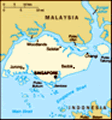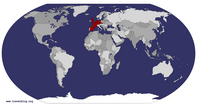Advertisement
Published: October 14th 2011
www.thetattooedtraveler.com In 1819, Sir Thomas Stamford Raffles established Singapore as an indispensable trading port for the British East India Company. Within five years, the British were in complete control of the island. Singapore became a seedy port town filled with sailors looking for debauchery, and locals willing to provide it. Nowadays, it’s billed as a gateway to Asia, a way to “dip your toe in the water” in this part of the world. A major cosmopolitan city, financial center and port, Singapore feels very Western—perhaps a bit too Western. Non-descript skyscrapers and countless malls abound, giving the city-center a generic, bland quality indistinguishable from other major cities. The British influence, in the form of colonial architecture, can still be felt all over the city.
Despite all this, it’s easy to find the authentic Asian Singapore. Not surprisingly, Chinatown is the place to start. After all, seventy-four percent of Singapore’s five million inhabitants are Chinese— and it’s all about the food! The various markets, street stalls, and low-budget-looking restaurants are the way to eat in Singapore. Don’t be nervous or put off by the idea of street food— strict governmental standards ensure the food is clean and safe and, judging
by the look of things, they don’t mess around!
Situated just beyond the skyscrapers and business center, Chinatown still retains a bit of colonial charm amid the Chinese influence. After checking into The Scarlet (33 Erskine Rd.), a boutique hotel in the heart of this neighborhood, we headed out to explore and find a place to eat. Wandering through the streets, we were solicited by every shopkeeper and restaurant owner we passed (we soon learned this was conventional practice in each Asian city we visited). We opted to eat at a restaurant filled with locals: Oriental Chinese Restaurant (195 New Bridge Rd.). The generic name aside, this place was really good. We had meat buns, prawn skewers, chicken heart skewers, and chili crab. I was apprehensive about the chicken hearts and looking forward to the chili crab, but I was wrong in both cases. The chicken hearts were terrific: juicy and flavorful with just the right amount of spice rub. On the other hand, I forgot what a chore it is to eat crab and how little crabmeat you actually get out of it.
The next morning we searched for Ya Kim, highly recommended for its kaya toast,
a Singapore breakfast specialty. We couldn’t find this small stall in the huge food center, so we opted for another place serving the same dish. The toast is covered with coconut jam and served with a very runny soft-boiled egg. The accompanying Kopi coffee is strong, but it’s sweetened with condensed milk and so good!
Beyond the culture and heritage of Chinatown lies Orchard Road, the major shopping drag in Singapore. Every inch of this area is, literally, lined with malls. It’s a sight to see, but very generic. Unless you’re looking to do some serious shopping, I would neither stay nor spend an extended amount of time in this section of the city. Just off Orchard Road, however, lies Emerald Road, a side street that offers a window into what Singapore looked like during the British Colonial period— definitely worth checking out.
Walking down Orchard towards the Marina brought us to the Singapore Art Museum, an old British colonial building housing modern art. Two of the galleries featured interesting paintings— modern takes on traditional Asian art and themes. The main exhibition was a collection of video work, which is not really my thing, so the building proved
to be more interesting than most of the art. Though we didn’t have time to visit, I think we should have opted for the National Museum instead.
The afternoon brought us to Yet Con (25 Pervis St.), a long running, no frills establishment famous for Hainanese chicken— boiled chicken and fresh chopped cucumbers served with broth and a bowl of rice. I know boiled chicken doesn’t sound appetizing, but it was really flavorful, though some chili sauce didn’t hurt. This is the place for Hainanese chicken in Singapore.
As we headed back towards our hotel to regroup for the evening, we walked along the waterfront, past the Marina. Beautiful parks, bridges, and views abound in this highly touristy area. The Marina home to the giant, somewhat strange Merlion statue (the symbol of the city) and beautiful views of Singapore’s financial district skyline. Worth seeing, but I wouldn’t spend all day there being jostled by tour groups.
Along the river, in what’s considered the heart of Singapore, you’ll find chain restaurants and cheesy activities that cater to tourists, but I found myself here looking for beer. Brewwerkz on Merchant Road in the Riverpoint Center felt a little like
a chain, but I couldn’t find any evidence to confirm nor deny that theory. They brew their own beer and that was enough convincing for me! I had:
• IPA, which according to their menu has won several awards
• Oatmeal stout, which tasted very typical
• “Black Rabbit,” a dark wheat beer made with banana and cloves
• Amber beer made from sticky rice
While the “Black Rabbit” was interesting, the amber was the real winner; perhaps because it’s brewed with local ingredients— rice— as opposed to imported ones. The beer was good, but the food menu was too “Western,” so we opted to eat elsewhere.
We headed back down to Smith Street in Chinatown. Otherwise known as “Food Street,” Smith closes down to traffic every night and becomes a pedestrian drag lined with food stalls and tables. What we think of as typical Chinese food abounds in this feast for the senses— chicken or seafood with fried rice or noodles is better than any you’ve had back in the States. For more daring eaters, delicacies such as stingray can be had as well. Though I can be adventurous at times, the stingray was just not calling out
to me. I had chicken fried rice with some spicy chili sauce and a huge (633ml) Tiger beer— not a bold choice, but so good! The only problem with chopsticks is that I can’t shovel the food down my throat fast enough!
The Maxwell Food Center in Chinatown is one of the best places to eat in the city! The stalls are numbered and easy to find— many only serving one specialty dish, as is the case with Zhen Zhen Porridge (#54). We went for breakfast, and the line was an hour long. I wasn’t sure if the guidebook recommended it because it was so popular or if it was so popular because the guidebook recommended it. Judging by all the locals waiting in line, I decided it was the former. This rice porridge comes with chicken or fish, scallions, some fried crispy stuff on top, and a raw egg, which cooks in the hot porridge. I added raw chilies for some more flavor. It was good and certainly worth trying, but it’s just not a Westerner’s idea of breakfast. The next morning we had a toasted coconut roll pastry at Pan Cake (#26). Definitely more my kind of
breakfast! We rounded that out with a fried dough fritter, a cup of Kopi coffee, and sugarcane juice with lemon. The Maxwell Food Center is definitely a must!
We took the MRT (subway) and spent an afternoon checking out the various Hindu and Buddhist temples in Little India. Though the temples are beautiful and definitely worth the trip, Little India is dirty, crowded, and a little seedy in some areas. The highlight is the Sakya Muni Buddha Gaya temple, which has a 15 meter high statue of Buddha and a piece of the Bodhi tree under which the Buddha is said to have reached enlightenment. Although I sometimes feel strange treating a religious place like a tourist attraction, the gentleman in charge was very friendly, pointing out various aspects and highlights of the temple. I guess the main thing to remember is that visiting a place of worship is a way to learn about and connect with other people. As long as visitors remain respectful, it’s okay— still, it feels strange.
The Lau Pa Sat Food Center in the financial district is probably the most beautiful in the city, and the variety and quality of the food is
terrific too! The building is a Victorian-style pavilion with beautiful, ornate, wrought iron details. This style of architecture, seen in many buildings and rail stations in Europe, is by far my favorite! I had pork noodles at stall number 102, coincidentally called Pork Noodles. The dish consisted of noodles and broth topped with some crispy, fried pork. So freakin’ good! Drinks are sold separately in the center of the pavilion. This food center is crowded with finance people on weekdays, but was relatively empty during the day on Saturday and Sunday.
The big tourist attraction is the Night Safari at the Singapore Zoo. We figured, why not? Night safari… large nocturnal predators… us not knowing where we are, unable to see… sounds like a recipe for fun! We took the MRT to the bus station at Ang Mo Kio and boarded a city bus for the zoo. As the bus pulled out and the engine revved, we quickly realized we weren’t accelerating very much at all. A few minutes later, as we made the first stop, we saw smoke and smelled burning rubber. That was our cue to get off the bus and wait for the next one. Everyone else had come to the same conclusion, and we soon realized that twice as many people would be waiting for the next already crowded bus. The buses to the zoo only run every hour or so, and by that time it was already getting late. We decided the Night Safari would have to wait until the next trip to Singapore. At least we broke down near the station and not an hour away in the middle of nowhere!
While Singapore may not be what you would call “truly Asian,” it does have a lot to offer, and yes, it is a good way to introduce yourself to Asian culture. It’s not a “must see” and I wouldn’t spend more than a few nights there, but if you’re going to Southeast Asia, it can be a good place to start your trip. It’s definitely a good introduction to Asian cuisine and that, in and of itself, is worth a visit.
Advertisement
Tot: 0.083s; Tpl: 0.01s; cc: 9; qc: 46; dbt: 0.0481s; 1; m:domysql w:travelblog (10.17.0.13); sld: 1;
; mem: 1.2mb









